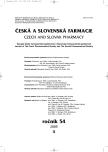A Comparison of the Efficacy of the Reactivators of Acetylcholinesterase Inhibited with Tabun
Authors:
J. Cabal; K. Kuča; D. Jun; J. Bajgar; M. Hrabinová
Authors‘ workplace:
Univerzita obrany v Hradci Králové, Fakulta vojenského zdravotnictví, Katedra toxikologie
Published in:
Čes. slov. Farm., 2005; 54, 192-195
Category:
Original Articles
Overview
The nerve agent tabun inhibits acetylcholinesterase (AChE; EC 3.1.1.7) by the formation of a covalent bond with the enzyme. Afterwards, AChE is not able to fulfil its role in the organism and subsequently cholinergic crisis occurs. AChE reactivators (pralidoxime, obidoxime and HI-6) as causal antidotes are used for the cleavage of the bond between the enzyme and nerve agent. Unfortunately, their potency for reactivation of tabun-inhibited AChE is poor. The aim of the study was to choose the most potent reactivator of tabun-inhibited AChE. We have tested eight AChE reactivators – pralidoxime, obidoxime, trimedoxime, HI-6, methoxime, Hlö-7 and our newly synthesized oximes K027 and K048. All reactivators were tested using our standard in vitro reactivation test (pH 8, 25°C, time of inhibition by the nerve agent 30 minutes, time of reactivation by AChE reactivator 10 minutes). According to our results, only trimedoxime was able to achieve 50% reactivation potency. However, this relatively high potency was achieved at high oxime concentration (10⁻² M). At a lower concentration of 10⁻⁴ M (the probably attainable concentration in vivo), four AChE reactivators (trimedoxime, obidoxime, K027, and K048) were able to reactivate AChE inhibited by tabun reaching from 10 to 18 %.
Key words:
acetylcholinesterase – reactivators – nerve agents – tabun – oxim
Labels
Pharmacy Clinical pharmacologyArticle was published in
Czech and Slovak Pharmacy

2005 Issue 4
Most read in this issue
- Methods of Artificial Intelligence: A New Trend in Pharmacy
- A Comparison of the Efficacy of the Reactivators of Acetylcholinesterase Inhibited with Tabun
- Advances in Enantioselective TLC of Therapeutic Agents
- Effect of Humectants on Pharmaceutical Availability and Rheological Properties of Loratadin- Containing Hydrogels
